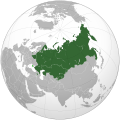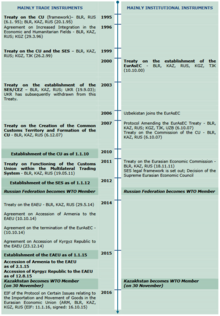
Back الاتحاد الجمركي الأوراسي Arabic Avrasiya Gömrük İttifaqı Azerbaijani Евразия таможня берлеге Bashkir Мытны саюз ЕАЭС Byelorussian Мытны зьвяз ЭАЭЗ BE-X-OLD Митнически съюз между Русия, Беларус и Казахстан Bulgarian Евразин экономикин бертан Таможнин барт CE Таможня пĕрлешĕвĕ ЕврАзЭП CV Ευρασιατική Τελωνειακή Ένωση Greek Unión Aduanera Euroasiática Spanish
Eurasian Customs Union | |
|---|---|
 | |
| Policy of | |
| Largest city | Moscow |
| Type | Customs union |
| Member states | |
| Establishment | 1 January 2010 |
| Area | |
• Total | 20,260,431 km2 (7,822,596 sq mi) |
| Population | |
• 2013 estimate | 182,519,270[1][2][3][4][5] |
• Density | 9.01/km2 (23.3/sq mi) |
| GDP (PPP) | 2016[6] estimate |
• Total | USD 4.5 trillion |
• Per capita | USD 25,000 |
| GDP (nominal) | 2016[6] estimate |
• Total | USD 1.5 trillion |
• Per capita | USD 8,000 |



This article has an unclear citation style. The reason given is: Extensive use of inline external links. (April 2024) |
The Customs Union of the Eurasian Economic Union (Russian: Таможенный союз Евразийского экономического союза) or EAEU Customs Union (Russian: Таможенный союз ЕАЭС) is a customs union of 5 post-Soviet states consisting of all the member states of the Eurasian Economic Union (Armenia, Belarus, Kazakhstan, Kyrgyzstan, Russia) which initially became effective on January 1, 2010 at the date of implementation of the common external tariff (CET) as the Customs Union of the Eurasian Economic Community or Customs Union of Russia, Belarus and Kazakhstan. It was inherited from the Eurasian Economic Community (terminated on January 1, 2015) and is now regulated by Part Two of the Treaty on the Eurasian Economic Union (which entered into force on January 1, 2015), EAEU Customs Code, other international agreements and by decisions of supranational bodies as Supreme Eurasian Economic Council, Intergovernmental Council and Eurasian Economic Commission.
No customs are levied on goods travelling within the customs union and – unlike a free-trade area – members of the customs union impose a common external tariff on all goods entering the union (the transition period for Armenia and Kyrgyzstan has ended, but Kazakhstan de jure has some opt-outs due to its obligations during WTO accession). The Union's rules are based on World Trade Organisation rules and WTO principles are binding on all members, but the Union is not a collective WTO member (in contrast the European Union). One of the consequences of the customs union is that the EAEU negotiates as a single entity in international trade agreements, such as free trade agreements in goods, instead of individual member states negotiating for themselves (Article 35 of the EAEU Treaty). The members states can be a separate members of WTO (all except Belarus as of 2024).
The founding documents in 1990s were the Agreement on the Customs Union between Russia and Belarus signed on January 6, 1995 in Minsk[10] and the Agreement on the Customs Union of Russia, Belarus and Kazakhstan signed in Moscow on January 20, 1995.[11] The Eurasian Economic Community, founded in 2000, has assumed responsibility for the implementation of previous agreements, created supranational bodies and finally launched the long-delayed customs union in 2010. According to the database of international treaties of the Eurasian Economic Union, these 1995 agreements are still in force as of 2024 and apply in part not contrary to the Treaty on the Eurasian Economic Union. [12][13][14] The launch date in 2010 of the Customs Union was set in 2007 as a result of a decision on common customs territory, CET and the formation of the customs union. Its founding states were Belarus, Kazakhstan, and Russia.[15] On 2 January 2015 it was enlarged to include Armenia. Kyrgyzstan acceded to the EEU on 6 August 2015.[16] Many provisions and separate agreements were codified, consolidated and incorporated into the EAEU Treaty and the EAEU's legal framework (officially "EAEU Treaty and international agreements within the EAEU" according to the database of law of the Eurasian Economic Union), some agreements were terminated and replaced, but some older agreements are still in force in part not contrary to the Treaty on the Eurasian Economic Union (officially "Other international treaties" according to the database of law of the Eurasian Economic Union[17]).
The member states continued with economic integration and removed all customs borders between each other after July 2011. On 19 November 2011, the member states put together a joint commission on fostering closer economic ties, planning to create a Eurasian Economic Union by 2015.[18][19] On 1 January 2012, the three states formed a single economic space to promote further economic integration.[19][20] The Eurasian Economic Commission is the regulatory agency for the Customs Union and the Eurasian Economic Community.[19]
The creation of the Eurasian Customs Union was guaranteed by 3 different treaties signed in 1995, 1999 and 2007.[citation needed] The first treaty in 1995 guaranteeing its creation, the second in 1999 guaranteeing its formation, and the third in 2007 announced the establishment of a common customs territory and the formation of the customs union.
- ^ "Демография – Численность и состав населения" [Demography – Population numbers and composition]. Federal State Statistics Service of the Russian Federation. Archived from the original on 2014-02-04. Retrieved 2018-12-28.
- ^ "The World Factbook". 23 December 2021.
- ^ "О демографической ситуации в январе-сентябре 2014 г." Archived from the original on 2014-10-31.
- ^ 2011թ. հոկտեմբերի 12-21-ը Հայաստանի Հանրապետությունում անցկացվեց հերթական մարդահամարը Archived 3 September 2013 at the Wayback Machine
- ^ Census
- ^ a b "World Economic Outlook Database, April 2017 – Report for Selected Countries and Subjects (Armenia, Belarus, Kazakhstan, Kyrgyz Republic, Russia)". International Monetary Fund. Retrieved 2018-12-28.
- ^ "WTO | Regional trade agreements".
- ^ "WTO | Regional trade agreements".
- ^ https://docsonline.wto.org/dol2fe/Pages/SS/directdoc.aspx?filename=q:/WT/REG/358-1.pdf&Open=True [bare URL]
- ^ https://docs.eaeunion.org/docs/ru-ru/0054920/itot_06112012 [bare URL]
- ^ https://docs.eaeunion.org/docs/ru-ru/0055079/itot_06112012 [bare URL]
- ^ https://docs.eaeunion.org/en-us/pages/alldocuments.aspx#npbdocumentbelongstaxId=%5B%7B%22id%22%3A%22b591e83f-0f9a-4fce-8760-758ac7690c84%22%2C%22title%22%3A%22International%20treaties%22%7D%5D [bare URL]
- ^ https://docs.eaeunion.org/docs/en-us/0054920/itot_06112012 [bare URL]
- ^ https://docs.eaeunion.org/docs/en-us/0055079/itot_06112012 [bare URL]
- ^ "Russia, Belarus and Kazakhstan Agree on Customs Union". Archived 2014-07-04 at the Wayback Machine. 5 December 2009
- ^ "Kyrgyzstan, Armenia officially enter Eurasian Economic Union". WorldBulletin.net. 2014-12-24. Retrieved 2018-12-28.
Kyrgyzstan and Armenia will officially enter the Eurasian Customs Union that was created by Russia, Belarus and Kazakhstan, on the January 1, 2015.
- ^ https://docs.eaeunion.org/en-us/pages/alldocuments.aspx#npbdocumentbelongstaxId=%5B%7B%22id%22%3A%22b591e83f-0f9a-4fce-8760-758ac7690c84%22%2C%22title%22%3A%22International%20treaties%22%7D%5D [bare URL]
- ^ "Russia, Belarus, Kazakhstan sign pact". UPI. 19 November 2011. Retrieved 20 November 2011.
- ^ a b c "Ukraine cannot get observer status at Eurasian Econ Union due to Association Agreement with EU, Russia", Interfax-Ukraine (14 June 2013)
- ^ Barron, Lisa (1 October 2013). "Belarus eases current account deficit with Customs Union, Common Economic Space". Cistran Finance. Archived from the original on 29 October 2013. Retrieved 25 October 2013.
© MMXXIII Rich X Search. We shall prevail. All rights reserved. Rich X Search